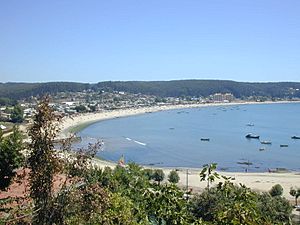Dichato facts for kids
Quick facts for kids
Dichato
|
||
|---|---|---|
|
Town
|
||

Dichato Bay in 2007
|
||
|
||
| Country | Chile | |
| Region | Biobío | |
| Province | Concepción | |
| Commune | Tomé | |
| Area | ||
| • Total | 3.95 km2 (1.53 sq mi) | |
| Population
(2017)
|
||
| • Total | 4,486 | |
| • Density | 1,135.7/km2 (2,941/sq mi) | |
Dichato is a pretty coastal town in the Biobío Region of central Chile. It is part of the Tomé commune. You can find it about 37 kilometers (23 miles) north of the city of Concepción. In 2017, about 4,486 people lived there.
Dichato is known for its quiet bay with calm, cold waters. This makes it a great spot for water sports, especially in summer. The town has many restaurants that serve fresh seafood. You can also find different hotels and places to stay. These are open all year, but they are busiest during the summer. When it's not summer, most people in Dichato work in artisanal fishing. You can often see their colorful boats.
A big earthquake and tsunami hit Dichato in February 2010. The flat parts of the town were badly damaged. The powerful sea destroyed many buildings.
Contents
What Does the Name Dichato Mean?
The name Dichato comes from the Mapuche language. One idea is that it comes from <düchantu. This word means "dichal" or "lots of dichas." Dichas are a type of spiny herb.
Another idea is that it comes from dücha (meaning "dicha") and ko (meaning "water"). Or maybe it comes from dëchatun, which means "to uproot dichas." Dichas are plants from the nictiginaceae family.
A Quick Look at Dichato's History
Dichato was started in 1826 by José Miguel Reyes. Later, in 1835, the famous scientist Charles Darwin visited the town. He was sailing on the ship Beagle. Darwin looked at the coal deposits in the area.
In 1856, Juan Mackay tried to mine coal here. But this effort did not last long. Later, between 1912 and 1920, Vicente Alberto Palacios leased the land. Then, Lautaro Rozas started a company called "Sociedad Carbonífera Dichato Limitada." Coal mining in Dichato slowed down after an earthquake in 1939. Other mines in Coronel and Lota became more important.
Daniel Vera was a mill owner and an important landowner in Dichato in the late 1800s. He shared his land with his children. One of his sons, Casimiro Vera Celedón, wrote poems about the area. The main street in Dichato is named after Daniel Vera. This street is also home to the town's main square.
From 1916 until the early 1990s, Dichato had train services. These trains connected it to Rucapequén and Concepción. Many summer visitors from Chillán used these trains. Regular passenger service stopped in the 1980s.
In 2005, a sewer system was built in Dichato. In 2007, a plant was built to clean wastewater. This helped keep the bay clean.
Earthquakes and Tsunami
The big earthquake in Chile in February 2010 caused a lot of damage. About 80% of Dichato was destroyed. Fishing, restaurants, and hotels were all affected. Many boats were washed into the town. The tsunami flooded 80 hectares (about 200 acres) of the town. The water reached up to four meters (13 feet) high.
One year later, in 2011, another earthquake hit Japan. This caused strong waves along the coast of Dichato. These waves dragged boats and damaged some homes.
Rebuilding Dichato
Dichato was rebuilt between 2011 and 2013. This was part of a big plan to rebuild coastal areas. The Ministry of Housing and Urbanization led this effort. It helped 18 towns affected by the 2010 earthquake.
During the rebuilding, some land near the beach was bought by the government. This was done to make the street wider. A "tsunami mitigation park" was also created. This park helps protect the town from future tsunamis. An 800-meter (about half a mile) long wall was built along the coast. A walking path was also added.
Around 600 homes were rebuilt. Some were moved to higher, safer areas. Others were built on stilts to protect them from water. The main road was improved. The "Daniel Vera" boulevard was also built.
How Dichato Makes Money
The main way people in Dichato earn money is through fishing. They catch fish and seafood. These are then sold locally. There are also special areas called "management areas" where people grow seafood like oysters, locos (a type of sea snail), and mussels.
Tourism has been important since the 1980s. Visitors enjoy recreational activities, local food restaurants, and places to stay. These include small hotels, residential homes, and private cabins.
In the last 20 years, more restaurants, bars, and nightclubs have opened. New apartment buildings have also been built for visitors. The biggest project is the private Pingueral complex.
Pingueral
The Pingueral residential complex is next to Dichato, right on Pingueral beach. For many years, only people who owned homes there could go to the beach. But in 2009, rules changed. Now, everyone has free access to the beaches.
Scientific Research in Dichato
Dichato is home to the Marine Biology Station. This station belongs to the University of Concepción. It opened in 1978. Scientists use this station for research. It also has a special scientific boat called "Kay-Kay."
Getting Around Dichato
You can get to Dichato using a paved road (Route CH-150). This road connects Concepción and Tomé. There is also a gravel road from the north, from Coelemu and Boca del Itata. This road is not always in the best condition.
During the summer, buses run often between Dichato, Tomé, and Concepción. You can also find shared taxis to Tomé. In winter, however, these services run much less often.
Images for kids
See also
 In Spanish: Dichato para niños
In Spanish: Dichato para niños







